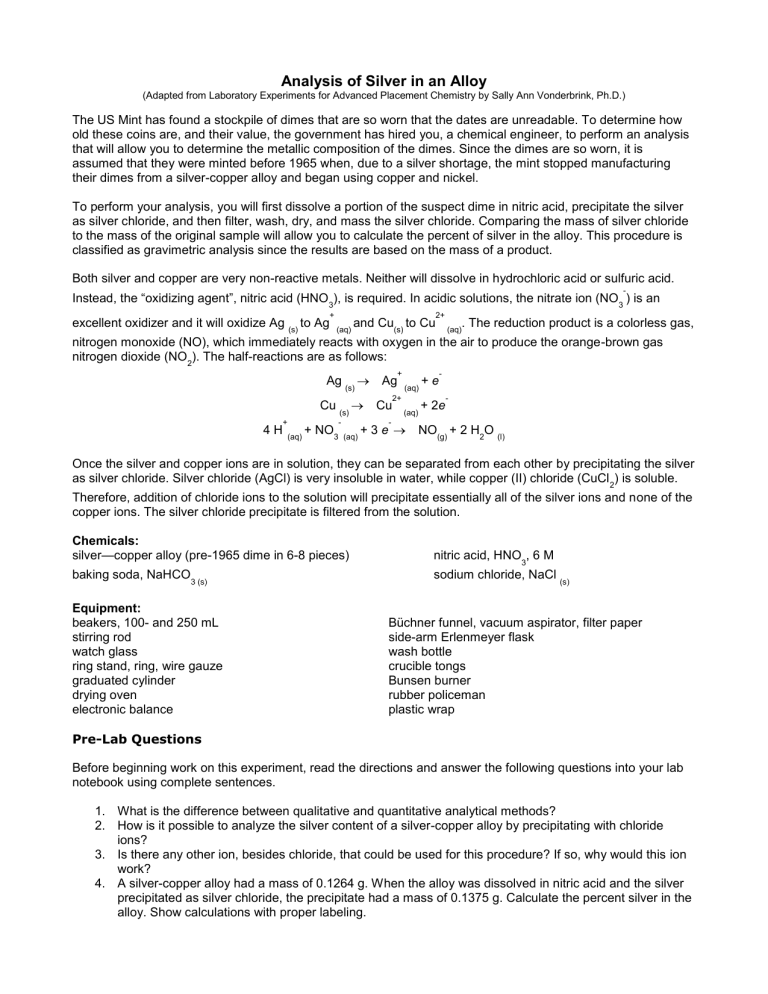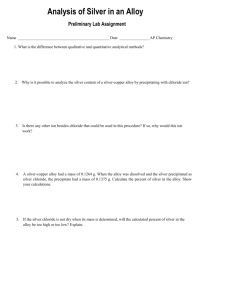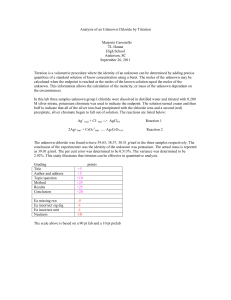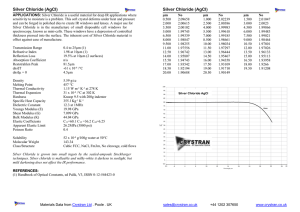
Analysis of Silver in an Alloy (Adapted from Laboratory Experiments for Advanced Placement Chemistry by Sally Ann Vonderbrink, Ph.D.) The US Mint has found a stockpile of dimes that are so worn that the dates are unreadable. To determine how old these coins are, and their value, the government has hired you, a chemical engineer, to perform an analysis that will allow you to determine the metallic composition of the dimes. Since the dimes are so worn, it is assumed that they were minted before 1965 when, due to a silver shortage, the mint stopped manufacturing their dimes from a silver-copper alloy and began using copper and nickel. To perform your analysis, you will first dissolve a portion of the suspect dime in nitric acid, precipitate the silver as silver chloride, and then filter, wash, dry, and mass the silver chloride. Comparing the mass of silver chloride to the mass of the original sample will allow you to calculate the percent of silver in the alloy. This procedure is classified as gravimetric analysis since the results are based on the mass of a product. Both silver and copper are very non-reactive metals. Neither will dissolve in hydrochloric acid or sulfuric acid. - Instead, the “oxidizing agent”, nitric acid (HNO3), is required. In acidic solutions, the nitrate ion (NO3 ) is an excellent oxidizer and it will oxidize Ag (s) to Ag + (aq) and Cu(s) to Cu 2+ . The reduction product is a colorless gas, (aq) nitrogen monoxide (NO), which immediately reacts with oxygen in the air to produce the orange-brown gas nitrogen dioxide (NO2). The half-reactions are as follows: + Ag (s) Ag - (aq) 2+ Cu (s) Cu 4H + - (aq) + NO3 +e - (aq) + 2e - (aq) + 3 e NO(g) + 2 H2O (l) Once the silver and copper ions are in solution, they can be separated from each other by precipitating the silver as silver chloride. Silver chloride (AgCl) is very insoluble in water, while copper (II) chloride (CuCl 2) is soluble. Therefore, addition of chloride ions to the solution will precipitate essentially all of the silver ions and none of the copper ions. The silver chloride precipitate is filtered from the solution. Chemicals: silver—copper alloy (pre-1965 dime in 6-8 pieces) nitric acid, HNO3, 6 M baking soda, NaHCO3 (s) sodium chloride, NaCl (s) Equipment: beakers, 100- and 250 mL stirring rod watch glass ring stand, ring, wire gauze graduated cylinder drying oven electronic balance Büchner funnel, vacuum aspirator, filter paper side-arm Erlenmeyer flask wash bottle crucible tongs Bunsen burner rubber policeman plastic wrap Pre-Lab Questions Before beginning work on this experiment, read the directions and answer the following questions into your lab notebook using complete sentences. 1. What is the difference between qualitative and quantitative analytical methods? 2. How is it possible to analyze the silver content of a silver-copper alloy by precipitating with chloride ions? 3. Is there any other ion, besides chloride, that could be used for this procedure? If so, why would this ion work? 4. A silver-copper alloy had a mass of 0.1264 g. When the alloy was dissolved in nitric acid and the silver precipitated as silver chloride, the precipitate had a mass of 0.1375 g. Calculate the percent silver in the alloy. Show calculations with proper labeling. 5. If the silver chloride is not dry when its mass is determined, will the calculated percent silver in the ally be too high or too low? Explain. Procedure: Safety Alert Nitric acid is an extremely corrosive substance that is damaging to skin and eyes. Use great care when you handle it. If you spill any on yourself, wash off with large amounts of water. Neutralize spills with baking soda. Solutions containing silver ions cause dark stains which do not appear for several hours. If you suspect that you spilled any silver ion solutions, immediately clean up with soap and water. 1. Find the Mass of the Alloy (Day 1) Obtain a sample of the silver alloy dime that is between 0.1 and 0.5 g. Determine its mass precisely on an analytical balance. Safety Alert As the silver-copper alloy dissolves, the gases nitrogen monoxide, NO, and nitrogen dioxide, NO 2, are evolved. Both of these gases are toxic, so this reaction must be carried out in a fume hood. 2. Dissolve the Silver Put the alloy in a clean, labeled, 100-mL beaker. In the fume hood, carefully pour 10 mL of 6 M nitric acid over it. Cover the beaker with a watch glass so none of the solution spatters out. It may be necessary to gently heat the solution in a warm sand bath so that the alloy totally dissolves. 3. Precipitate the Silver Calculate the amount of sodium chloride that would be necessary to precipitate the silver in your sample, assuming that the sample is 100% silver. Use a balance sensitive to ± 0.01 g to mass out two times this amount of sodium chloride. Dissolve the sodium chloride in 25 mL of distilled water. Remove the watch glass from the first beaker, and rinse any moisture on the bottom of the watch glass back into the beaker with your wash bottle to be sure that no silver is lost. To precipitate the silver as silver chloride, slowly add the sodium chloride solution to the dissolved silver. Stir with a stirring rod, and rinse any solution clinging to the rod into the beaker with distilled water. Cover the beaker with plastic wrap and allow it to stand overnight. This will allow the precipitate particles to grow larger. 4. Prepare a Büchner Funnel (Day 2) To filter the solution, a Büchner Funnel will be used with a vacuum aspirator and a filter flask. Refer to Figure 1 below to see how the funnel, filter paper, aspirator, and flask are assembled. Use masking tape to label your funnel. On an analytical balance, mass the funnel assembly. Figure 1: Büchner Funnel assembly 5. Filter the Silver Chloride Place your Büchner funnel (with filter paper) into a side arm flask and attach the assembly to a vacuum aspirator. Turn on the water. Pour some distilled water through the filter with suction to be sure that the filter paper firmly seals the bottom of the funnel. In your wash bottle, add 2 mL of 6 M HNO3 to 150 mL of distilled water. Label your wash bottle appropriately. Use this as a rinse. The addition of the acid to the rinse water helps to keep the precipitate from “peptizing”, or forming extremely small particles that will run through the filter. Carefully pour the solution above the silver chloride down a stirring rod into the funnel. Wash the precipitate into the funnel with the dilute nitric acid solution. Be sure to get every particle! A rubber policeman on a stirring rod can be used as a squeegee to clean the sides of the beaker. Rinse the precipitate several times with the wash solution. To turn off the suction, remove the tubing from the flask BEFORE turning off the water. This prevents the possibility of the filtrate being pushed up through the funnel backwards. 6. Dry the Silver Chloride and Determine Its Mass Put the top of the Büchner funnel with silver chloride in the drying oven overnight. Day 3: When it is dry and cool, find the mass of the Büchner funnel with silver chloride on an analytical balance. Discussion: Answer in complete sentences in your laboratory notebook. 1. Why is a twofold excess of chloride added to precipitate the silver? 2. Why don’t you have to mass the sodium chloride on a sensitive balance? 3. Why is it necessary to wash the precipitate? 4. Will the nitric acid in the wash water interfere with the weight of the silver chloride? (Nitric acid is prepared by dissolving the gas N2O5 in water.) 5. If the funnel containing the silver chloride is not cool when its mass is determined, will the calculated percent silver be too high or to low? Why? 6. Why don’t we just use hydrochloric acid to both dissolve and precipitate the silver? 7. Why is a Büchner funnel used rather than an ordinary funnel? The following questions may require you to perform additional research. Please cite all references in your answers. 8. What was your calculated percent silver in the original sample? Does this answer support the original hypothesis that this dime was minted prior to 1965? Use the accepted value to calculate a percent error. 9. Calculate the mass of silver in your original alloy sample. Using this mass and the current price of silver calculate how much the silver in this experiment was worth. 10. Would this procedure work for a quarter? Explain your answer.



